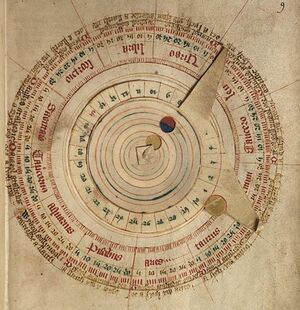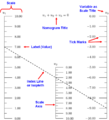Volvelle (nonfiction): Difference between revisions
(Created page with "A '''volvelle''' or wheel chart is a type of slide chart, a paper construction with rotating parts. It is considered an early example of a paper analog computer. Volvelles hav...") |
No edit summary |
||
| (4 intermediate revisions by the same user not shown) | |||
| Line 1: | Line 1: | ||
A '''volvelle''' or wheel chart is a type of slide chart, a paper construction with rotating parts | [[File:Volvelle of the moon.jpg|thumb|A volvelle of the moon. 15th century.]]A '''volvelle''', '''vovella''', or '''wheel chart''' is a type of slide chart, a paper construction with rotating parts. Volvelles have been produced to accommodate organization and calculation in many diverse subjects. | ||
It is considered an early example of a paper analog computer. | |||
Early examples of volvelles are found in the pages of astronomy books. They can be traced back to "certain Arabic treatises on humoral medicine", and to the Persian astronomer [[Al-Biruni (nonfiction)|Abu Rayhan Biruni]] (c. 1000), who made important contributions to the development of the volvelle. | |||
In the twentieth century, the volvelle had many diverse uses. In Reinventing the Wheel, author Jessica Helfand introduces twentieth-century volvelles with this: | In the twentieth century, the volvelle had many diverse uses. In Reinventing the Wheel, author Jessica Helfand introduces twentieth-century volvelles with this: | ||
The twentieth century saw a robust growth in the design, manufacture, and production of a new generation of independent, free-standing volvelles. Categorically, they not only represent an unusually eclectic set of uses, but demonstrate, too, a remarkable range of stylistic, compositional, mechanical, informational, and kinetic conceits. There are volvelles that arrange their data peripherally, centrifugally, and radially; volvelles that use multiple concentric circles with pointers; and volvelles that benefit from the generous use of the die-cut, a particular technological hallmark of modern printing manufacture. Twentieth-century volvelles—often referred to as wheel charts—offer everything from inventory control to color calibration, mileage metering to verb conjugation. They anticipate animal breeding cycles and calculate radiation exposure, measure chocolate consumption and quantify bridge tips, chart bird calls, convert metrics, and calculate taxes. There are fortune-telling wheels and semaphore-charting wheels; emergency first-aid wheels and electronic fix-it wheels; playful wheels that test phonetics and prophylactic wheels that prevent pregnancy. | <blockquote>The twentieth century saw a robust growth in the design, manufacture, and production of a new generation of independent, free-standing volvelles. Categorically, they not only represent an unusually eclectic set of uses, but demonstrate, too, a remarkable range of stylistic, compositional, mechanical, informational, and kinetic conceits. There are volvelles that arrange their data peripherally, centrifugally, and radially; volvelles that use multiple concentric circles with pointers; and volvelles that benefit from the generous use of the die-cut, a particular technological hallmark of modern printing manufacture. Twentieth-century volvelles—often referred to as wheel charts—offer everything from inventory control to color calibration, mileage metering to verb conjugation. They anticipate animal breeding cycles and calculate radiation exposure, measure chocolate consumption and quantify bridge tips, chart bird calls, convert metrics, and calculate taxes. There are fortune-telling wheels and semaphore-charting wheels; emergency first-aid wheels and electronic fix-it wheels; playful wheels that test phonetics and prophylactic wheels that prevent pregnancy.</blockquote> | ||
The rock band Led Zeppelin employed a volvelle in the sleeve design for the album Led Zeppelin III (1970). | The rock band Led Zeppelin employed a volvelle in the sleeve design for the album Led Zeppelin III (1970). | ||
== In the News == | |||
<gallery> | |||
File:Ishango bone.jpg|link=Computation (nonfiction)|Steganographic analysis of the [[Computation (nonfiction)|Ishango bone]] unexpectedly reveals new class of volvelles. | |||
File:Components of a Nomogram.png|link=Nomogram (nonfiction)|[[Nomogram (nonfiction)|Nomogram]] says it will retrain for career as volvelle. | |||
</gallery> | |||
== Fiction cross-reference == | |||
* [[Crimes against mathematical constants]] | |||
* [[Gnomon algorithm]] | |||
* [[Gnomon Chronicles]] | |||
* [[Mathematician]] | |||
* [[Mathematics]] | |||
== Nonfiction cross-reference == | |||
* [[Computation (nonfiction)]] | |||
* [[Function (nonfiction)]] | |||
* [[Nomogram (nonfiction)]] | |||
* [[Slide rule (nonfiction)]] | |||
External links: | |||
* [https://en.wikipedia.org/wiki/Volvelle Volvelle] @ Wikipedia | |||
[[Category:Nonfiction (nonfiction)]] | |||
[[Category:Computers (nonfiction)]] | |||
[[Category:Computation (nonfiction)]] | |||
[[Category:Mathematics (nonfiction)]] | |||
Latest revision as of 12:15, 15 April 2018
A volvelle, vovella, or wheel chart is a type of slide chart, a paper construction with rotating parts. Volvelles have been produced to accommodate organization and calculation in many diverse subjects.
It is considered an early example of a paper analog computer.
Early examples of volvelles are found in the pages of astronomy books. They can be traced back to "certain Arabic treatises on humoral medicine", and to the Persian astronomer Abu Rayhan Biruni (c. 1000), who made important contributions to the development of the volvelle.
In the twentieth century, the volvelle had many diverse uses. In Reinventing the Wheel, author Jessica Helfand introduces twentieth-century volvelles with this:
The twentieth century saw a robust growth in the design, manufacture, and production of a new generation of independent, free-standing volvelles. Categorically, they not only represent an unusually eclectic set of uses, but demonstrate, too, a remarkable range of stylistic, compositional, mechanical, informational, and kinetic conceits. There are volvelles that arrange their data peripherally, centrifugally, and radially; volvelles that use multiple concentric circles with pointers; and volvelles that benefit from the generous use of the die-cut, a particular technological hallmark of modern printing manufacture. Twentieth-century volvelles—often referred to as wheel charts—offer everything from inventory control to color calibration, mileage metering to verb conjugation. They anticipate animal breeding cycles and calculate radiation exposure, measure chocolate consumption and quantify bridge tips, chart bird calls, convert metrics, and calculate taxes. There are fortune-telling wheels and semaphore-charting wheels; emergency first-aid wheels and electronic fix-it wheels; playful wheels that test phonetics and prophylactic wheels that prevent pregnancy.
The rock band Led Zeppelin employed a volvelle in the sleeve design for the album Led Zeppelin III (1970).
In the News
Steganographic analysis of the Ishango bone unexpectedly reveals new class of volvelles.
Nomogram says it will retrain for career as volvelle.
Fiction cross-reference
Nonfiction cross-reference
External links:
- Volvelle @ Wikipedia


